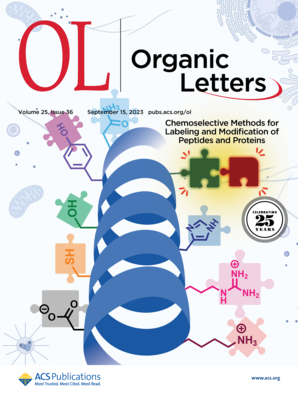通过自由基-极性交叉机制实现苯乙烯与二氧化碳和芳基卤化物的电还原芳基羧化反应
IF 5
1区 化学
Q1 CHEMISTRY, ORGANIC
引用次数: 0
摘要
2,3-二芳基丙酸是一种重要的结构,因为它们广泛存在于许多生物活性化合物中。然而,现有合成技术的局限性包括需要昂贵的催化剂和有限的底物。在此,我们开发了一种新型的烯烃与二氧化碳的电还原芳基羧化方法,该方法基于自由基-极性交叉途径,并以易于获得的对苯二甲酸二甲酯作为还原介质。这种方法将为 2,3-二元丙酸的合成提供一种有效的策略。本文章由计算机程序翻译,如有差异,请以英文原文为准。


Electroreductive Arylcarboxylation of Styrenes with CO2 and Aryl Halides via a Radical–Polar Crossover Mechanism
2,3-Diaryl propanoic acids are important structures as a result of their widespread presence in numerous bioactive compounds. However, the limitations of existing synthetic techniques include the requirement for costly catalysts and limited substrates. Here, we developed a novel electroreductive arylcarboxylation of alkenes with CO2 based on a radical–polar crossover pathway assisted by easily accessible dimethyl terephthalate as a reductive mediator. This method will provide an efficient strategy for the synthesis of 2,3-diarylpropanoic acids.
求助全文
通过发布文献求助,成功后即可免费获取论文全文。
去求助
来源期刊

Organic Letters
化学-有机化学
CiteScore
9.30
自引率
11.50%
发文量
1607
审稿时长
1.5 months
期刊介绍:
Organic Letters invites original reports of fundamental research in all branches of the theory and practice of organic, physical organic, organometallic,medicinal, and bioorganic chemistry. Organic Letters provides rapid disclosure of the key elements of significant studies that are of interest to a large portion of the organic community. In selecting manuscripts for publication, the Editors place emphasis on the originality, quality and wide interest of the work. Authors should provide enough background information to place the new disclosure in context and to justify the rapid publication format. Back-to-back Letters will be considered. Full details should be reserved for an Article, which should appear in due course.
 求助内容:
求助内容: 应助结果提醒方式:
应助结果提醒方式:


